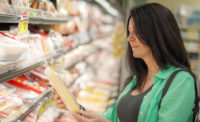Health and weight maintenance discussions are spreading to the supermarket aisles according to Shopping for Health 2010, the 18th annual study from theFood Marketing Institute(FMI) andPrevention, and published byRodale Inc.
With a keen eye to nutrition labels, nearly half (43 percent) of consumers polled said they’re paying more attention to calorie counts than they were two years ago.
Study authors also noted that technology is invading the aisles as one-third of shoppers find it appealing to use smartphone “Apps” to create grocery lists. More than 25 percent of shoppers also opt to get updates from retailers on sales and specials via an “App;” one-quarter of shoppers like the idea of using “Apps” to choose healthy items.
“This research is extremely valuable as supermarkets promote the health and wellness of their customers as a central part of their mission," noted FMI President & CEO Leslie Sarasin. "Most important, it tells us what consumers need to learn about eating healthy foods and how we can best help them as company dietitians teach customers how to improve their diets through store tours, cooking classes and other educational programs."
Prevention’sDirector of Consumer Insights, Cary Silvers, added, “America's calorie conundrum: more attention does not mean more precision. While many American's are paying more attention to calories, they have a long way to go towards knowing how many they consume in an average day. This is the next line of opportunity in calorie management.”
Calorie concerns
Calorie counts are not new, but the increased level of concern is evident in findings such as more shoppers are paying attention to the counts, and one-quarter of shoppers are buying more low or zero calorie products than last year.
However, more attention to calories does not mean more precision. The majority of shoppers just loosely try to watch how many calories they consume.
-- 9 percent actively count how many calories they consume
-- 50 percent say they just "watch" their calories
-- 41 percent don’t watch at all
Many shoppers greatly underestimate what they consume by meal type. In total, the majority of them believe they consume the daily-recommended amount of calories.
Breakfast – 60 percent say they consume 300 or fewer calories (Bagel with low fat cream cheese= 460 calories)
Lunch – 61 percent say they consume 300-500 calories (Turkey sandwich on whole wheat=480 calories)
Snack – 74 percent say they consume 300 or fewer calories (4 Chocolate chip cookies=640 calories)
Dinner – 65 percent say they consume 500 or more calories (¼ chicken and sides=640 calories)
Taxing unhealthy foods
In the discussion to tax unhealthy foods to lower consumption and help obesity rates, shoppers are not in agreement quite yet.
25 percent of shoppers say it is “OK” to tax unhealthy foods. Of those who said yes, fast food received the most votes to be taxed (70 percent) with soda (67 percent) and items with trans fats (64 percent) not far behind.
Interestingly, Bacon (19 percent) and Butter (10 percent) are safer in the eyes of consumers
Apps make shopping and eating healthier easier
“Apps” make smartphones even more useful and a small but growing number of shoppers see the potential of “Apps” for making cost-effective shopping and healthy eating, easier.
Shoppers say “Apps” are appealing (whether or not they own a smartphone)
33 percent – to create a grocery list
28 percent – from retailer to notify you of sales and specials
25 percent – to choose healthy items when shopping
The economy, shopping
Shoppers continue to eat at home vs. dining out and spend at the supermarket or local food retailer.
24 percent of shoppers are spending more at the grocery store than before the economic crash.
In the store, many shoppers continue to favor necessities over impulse purchases.
-- 77 percent buy only what they need
-- 53 percent cut out buying premium versions
-- Impulse buying is dominated by two words: “on sale." Forty-five percent buy on-sale items, even if not on their list.
-- Private label buying is considerable: 48 percent switched to a store brand in 2009.
New, healthy meal choices
More meal preparation leads shoppers to do the following…
35 percent say they did more cooking from scratch vs. the previous year
34 percent of shoppers say they tried more new recipes vs. the previous year
24 percent say they used a slow cooker more than in the previous year
52 percent of shoppers tried a new healthy recipe in the past year.
Type of healthy recipe they tried:
69 percent -- chicken
59 percent -- salad
52 percent -- soup
46 percent -- pasta/rice dish
41 percent -- fish
32 percent -- sandwich
30 percent -- vegetarian dish
30 percent -- dessert
17 percent -- steak
When trying to eat healthier, shoppers do this half or more of the time.
58 percent – Swapping: opt for the healthier version of a product
52 percent – Switching: switch one product for a healthier alternative
47 percent – Stopping: stop buying less-healthy products
47 percent – Cutting: continue to buy less-healthy products, just eat less or smaller portions
46 percent – Adding: buy healthy products not purchased before
Top label concerns
Sodium levels are the new top label concern (66 percent), tied with fat (66 percent) and followed closely by sugar/artificial sweeteners (65 percent) and calories (60 percent).
Compared to last year, more than one-third of shoppers say they’re buying products with more grains (whole grain, 49 percent; multigrain, 40 percent), fiber (39 percent), low-fat (37 percent) and low-sodium (34 percent).
Methodology: This report is based on a national online survey of more than 1,423 adult shoppers, conducted by Harris Interactive in December 2009 on behalf of FMI and Prevention. All respondents had primary or equally shared responsibility for his or her household’s grocery shopping.
Get our new eMagazine delivered to your inbox every month.
Stay in the know on the latest food and beverage manufacturing markets.
SUBSCRIBE TODAYCopyright ©2024. All Rights Reserved BNP Media.
Design, CMS, Hosting & Web Development :: ePublishing


